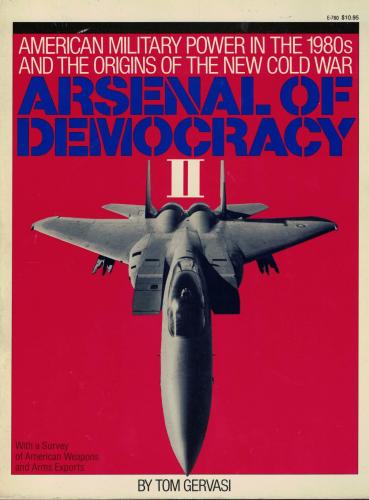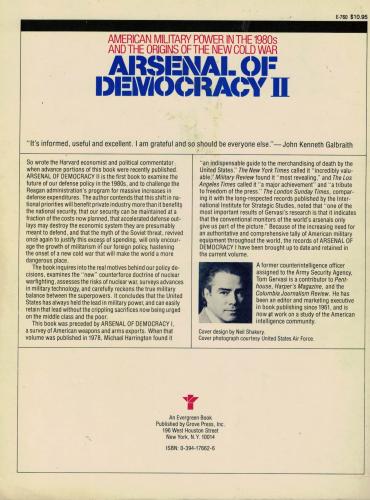
Arsenal of Democracy II American Military Power in the 1980s and the Origins of the New Cold War, Tom Gervasi, 63378, Grove Press, Eğitim Kitapları, Tarih Siyaset Ekonomi, Yabancı Dilde Kitaplar
AMERİCA'S TOLE IN THE ARNS TRADE
IN In the past decade the United States always a major producer and supplier of arms, has taken the lead in an increas- ingly competitive market and become the world's foremost merchant of mili- tary hardware. This country is now re- sponsible for more than half of the $22 billion in weapons currently traded each year. Our closest competitor, the Soviet Union, can account for only about 24 percent of that total. France and Britain follow, with arms exports of $1.9 billion and $1.4 billion respectively.
The Policy of Deterrence
Several factors have contributed to the American ascendancy in the arms trade The ambivalence of our foreign policy has played an important role. Over the past twenty years, as we developed a posture of detente with the Soviet sphere, we began to reduce force levels abroad, withdrawing some American troops and closing some military bases At the same time, we increased arm:s exports and military aid to the very cour tries we had quit. For while we hoped to reduce international tensions, and to en courage reciprocation from the Soviet Union, we also wished to ensure the security of those areas of the world no longer directly protected by the Ameri- can presence.
The assumptions behind this policy have been outlined by Deputy Secretary of Defense Charles Duncan in his tes- timony to Congress of 24 March 1977: We believe that when countries know that they are capable of defending themselves, they will be more likely to feel secure enough to hazard a negotiated peace, less likely to take preemptive military measures, and less likely to require direct U.S. assistance.
This reflects two of the basic convid- tions held by those in our country who make or deploy arms. They believe that arms are a deterrent, needed not to make war but to preserve the peace They also believe that arms can be arnequivalent to our own combat troops as a deterrent force, eliminating the need for direct American support.
The influx of arms that consequently foliows American force reductions abroad demonstrates that, while we had first hoped to diminish the level of tension between certain nations, what ultimately concerns us more is to ensure that those who confront our allies in our absence will remain as cautious as they ever were. The weapons we export are meant to sustain a sufficient level of ten- sion to guarantee such caution. The new level of tension may equal or even surpass the old, and thus the results may at times contradict our original intent.
These attitudes continue to prevail, and promise in the near future to ac- count for a sizeable increase in our arms exports, despite recent expressions of hope to reduce them. In the wake, for example, of the planned withdrawal of 33,000 American troops of the Second Infantry Division and other units from South Korea, a sale of more than $8 billion in arms to that country has been proposed, including missiles, destroyers, helicopters, field artillery, and 240 jet fighter aircraft, 90 of them newgeneration F-16s, together with technical
(Kitabın ilk sayfası)
Kitap, ucuz kitap, kitap al, kitap satın al, ucuz kitap al, uygun kitap, en uygun kitap, en ucuz kitap, kitap al bul, ucuza kitap al, en ucuz kitap al, hesaplı kitap, ucuz kitap satın al, incikitap com,
ÖNEMLİ AÇIKLAMA: Siz değerli okuyuculara satışa sunduğumuz ürünlerin büyük kısmı “kullanılmış ikinci el” kitaplardır. Kitap ve süreli yayınlar mezatlarında ürünlerin ilk sahibi ve sonraki sahipleri sayfaları yazı,çizim ya da notlar almış olabilir. Sonuç itibariyle daha önceden bir veya daha fazla kişi tarafından kullanılmış olabileceğini lütfen göz ardı etmeyiniz. Satışa sunduğumuz kitapların genel görünümü herkesçe kabul edilebilir standartlara uygun olarak ve olabildiğince açık bir şekilde belirtmeye, fotoğraflamaya gayret gösteren İNCİKİTAP sitemizi gezdiğiniz için şimdiden teşekkür ederiz. Mutlu Kitap Okumalar Dileğiyle.
Arsenal of Democracy II American Military Power in the 1980s and the Origins of the New Cold War, Tom Gervasi, 63378, Grove Press, Eğitim Kitapları, Tarih Siyaset Ekonomi, Yabancı Dilde Kitaplar
AMERİCA'S TOLE IN THE ARNS TRADE
IN In the past decade the United States always a major producer and supplier of arms, has taken the lead in an increas- ingly competitive market and become the world's foremost merchant of mili- tary hardware. This country is now re- sponsible for more than half of the $22 billion in weapons currently traded each year. Our closest competitor, the Soviet Union, can account for only about 24 percent of that total. France and Britain follow, with arms exports of $1.9 billion and $1.4 billion respectively.
The Policy of Deterrence
Several factors have contributed to the American ascendancy in the arms trade The ambivalence of our foreign policy has played an important role. Over the past twenty years, as we developed a posture of detente with the Soviet sphere, we began to reduce force levels abroad, withdrawing some American troops and closing some military bases At the same time, we increased arm:s exports and military aid to the very cour tries we had quit. For while we hoped to reduce international tensions, and to en courage reciprocation from the Soviet Union, we also wished to ensure the security of those areas of the world no longer directly protected by the Ameri- can presence.
The assumptions behind this policy have been outlined by Deputy Secretary of Defense Charles Duncan in his tes- timony to Congress of 24 March 1977: We believe that when countries know that they are capable of defending themselves, they will be more likely to feel secure enough to hazard a negotiated peace, less likely to take preemptive military measures, and less likely to require direct U.S. assistance.
This reflects two of the basic convid- tions held by those in our country who make or deploy arms. They believe that arms are a deterrent, needed not to make war but to preserve the peace They also believe that arms can be arnequivalent to our own combat troops as a deterrent force, eliminating the need for direct American support.
The influx of arms that consequently foliows American force reductions abroad demonstrates that, while we had first hoped to diminish the level of tension between certain nations, what ultimately concerns us more is to ensure that those who confront our allies in our absence will remain as cautious as they ever were. The weapons we export are meant to sustain a sufficient level of ten- sion to guarantee such caution. The new level of tension may equal or even surpass the old, and thus the results may at times contradict our original intent.
These attitudes continue to prevail, and promise in the near future to ac- count for a sizeable increase in our arms exports, despite recent expressions of hope to reduce them. In the wake, for example, of the planned withdrawal of 33,000 American troops of the Second Infantry Division and other units from South Korea, a sale of more than $8 billion in arms to that country has been proposed, including missiles, destroyers, helicopters, field artillery, and 240 jet fighter aircraft, 90 of them newgeneration F-16s, together with technical
(Kitabın ilk sayfası)
Kitap, ucuz kitap, kitap al, kitap satın al, ucuz kitap al, uygun kitap, en uygun kitap, en ucuz kitap, kitap al bul, ucuza kitap al, en ucuz kitap al, hesaplı kitap, ucuz kitap satın al, incikitap com,
ÖNEMLİ AÇIKLAMA: Siz değerli okuyuculara satışa sunduğumuz ürünlerin büyük kısmı “kullanılmış ikinci el” kitaplardır. Kitap ve süreli yayınlar mezatlarında ürünlerin ilk sahibi ve sonraki sahipleri sayfaları yazı,çizim ya da notlar almış olabilir. Sonuç itibariyle daha önceden bir veya daha fazla kişi tarafından kullanılmış olabileceğini lütfen göz ardı etmeyiniz. Satışa sunduğumuz kitapların genel görünümü herkesçe kabul edilebilir standartlara uygun olarak ve olabildiğince açık bir şekilde belirtmeye, fotoğraflamaya gayret gösteren İNCİKİTAP sitemizi gezdiğiniz için şimdiden teşekkür ederiz. Mutlu Kitap Okumalar Dileğiyle.
| Taksit Sayısı | Taksit tutarı | Genel Toplam |
|---|---|---|
| Tek Çekim | 1.007,73 | 1.007,73 |
| 2 | 534,30 | 1.068,60 |
| 3 | 361,37 | 1.084,12 |
| 6 | 187,15 | 1.122,91 |
| Taksit Sayısı | Taksit tutarı | Genel Toplam |
|---|---|---|
| Tek Çekim | 1.007,73 | 1.007,73 |
| 2 | 534,30 | 1.068,60 |
| 3 | 361,37 | 1.084,12 |
| 6 | 187,15 | 1.122,91 |
| Taksit Sayısı | Taksit tutarı | Genel Toplam |
|---|---|---|
| Tek Çekim | 1.007,73 | 1.007,73 |
| 2 | 534,30 | 1.068,60 |
| 3 | 361,37 | 1.084,12 |
| 6 | 187,15 | 1.122,91 |
| Taksit Sayısı | Taksit tutarı | Genel Toplam |
|---|---|---|
| Tek Çekim | 1.007,73 | 1.007,73 |
| 2 | 534,30 | 1.068,60 |
| 3 | 361,37 | 1.084,12 |
| 6 | 187,15 | 1.122,91 |
| Taksit Sayısı | Taksit tutarı | Genel Toplam |
|---|---|---|
| Tek Çekim | 1.007,73 | 1.007,73 |
| 2 | 534,30 | 1.068,60 |
| 3 | 361,37 | 1.084,12 |
| 6 | 187,15 | 1.122,91 |
| Taksit Sayısı | Taksit tutarı | Genel Toplam |
|---|---|---|
| Tek Çekim | 1.007,73 | 1.007,73 |
| 2 | 534,30 | 1.068,60 |
| 3 | 361,37 | 1.084,12 |
| 6 | 187,15 | 1.122,91 |
| Taksit Sayısı | Taksit tutarı | Genel Toplam |
|---|---|---|
| Tek Çekim | 1.007,73 | 1.007,73 |
| 2 | - | - |
| 3 | - | - |
| 6 | - | - |



